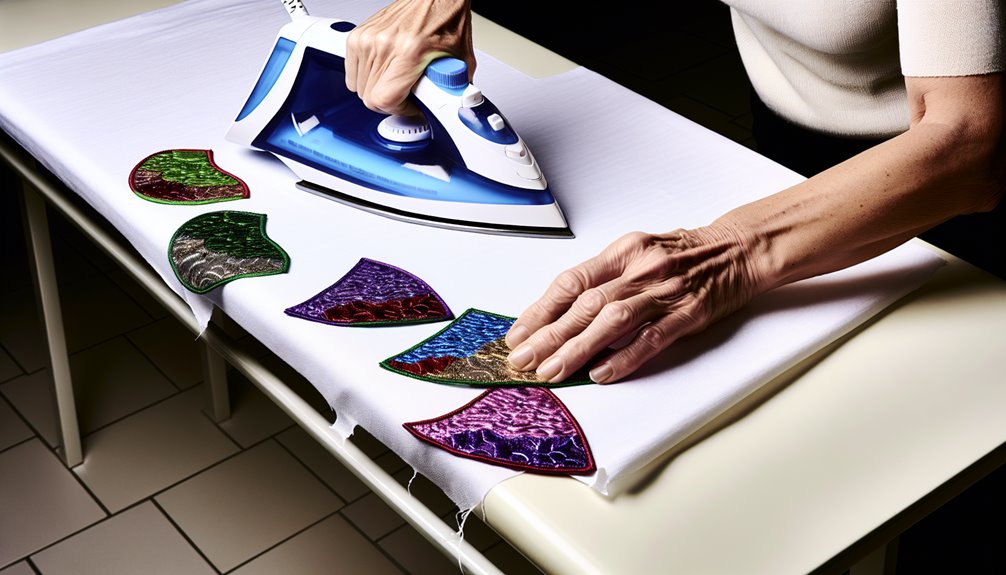Ironing embroidery patches onto fabric requires a keen understanding of the patch materials and appropriate heat settings. The choice of temperature can make the difference between a secure, long-lasting application and one that fails to adhere properly. Guiding through this process, however, is not as straightforward as it may seem. Factors such as the patch composition and the underlying garment fabric must be carefully considered to achieve the perfect balance. Discover the essential tips that guarantee a professional, damage-free result when adding embroidered patches to your textile projects.
Understanding Patch Materials
The materials used in embroidery patches can vary considerably. Common materials include cotton, polyester, and rayon. Cotton patches are soft and breathable, making them suitable for casual wear. Polyester patches are durable and wrinkle-resistant, ideal for activewear. Rayon patches have a silk-like sheen and drape, often used in high-end fashion. Patches may also contain a backing material, such as fusible web or iron-on adhesive, to facilitate application. The thickness and texture of the patch can affect the ironing process, requiring adjustments to temperature and pressure. Understanding the patch composition is essential for successful and damage-free application.
Determining the Optimal Iron Temperature
Determining the ideal iron temperature is vital for successfully applying embroidery patches without causing damage. The appropriate temperature depends on the patch material. For delicate fabrics like silk or satin, a low-to-medium heat setting is recommended to prevent scorching. Conversely, sturdy materials like denim or canvas may require higher heat to guarantee a secure bond. It’s important to perform a patch test on a hidden area before ironing the entire piece. This allows you to adjust the temperature as needed to achieve the desired result without compromising the fabric or the patch. Careful temperature regulation is key to a professional-looking, long-lasting application.
Preparing the Garment and Patch for Ironing
Before commencing the ironing process, thorough preparation of both the garment and the patch is essential. The garment should be placed on a flat, heat-resistant surface, ensuring it is free of any wrinkles or creases. The embroidery patch should be positioned on the desired location, taking care to align it correctly. It is vital to check that the patch is compatible with the fabric type and can withstand the heat from the iron. Proper alignment and preparation will help achieve a seamless and professional-looking application of the embroidered patch.
Technique for Applying the Embroidery Patch
Carefully position the embroidery patch on the desired area of the garment, ensuring proper alignment and a smooth application. Use a medium-hot iron, avoiding excessive heat that could damage the fabric or embroidery. Apply the iron with gentle, even pressure, moving it in small circular motions to activate the adhesive backing. Avoid sliding the iron, as this may cause the patch to shift.
| Step | Action |
|---|---|
| 1 | Place the garment on a flat, heat-resistant surface. |
| 2 | Position the embroidery patch and smooth it with your fingers. |
| 3 | Cover the patch with a pressing cloth and iron for 30-60 seconds. |
| 4 | Allow the area to cool completely before removing the pressing cloth. |
Ensuring a Long-Lasting and Professional Finish
To guarantee the embroidery patch maintains a long-lasting and professional appearance, it is important to properly secure it to the garment. Ironing the patch at the correct temperature helps the adhesive bond fully with the fabric. Using a pressing cloth protects the delicate stitching. Pressing firmly and evenly across the entire patch guarantees complete contact. Allowing the patch to cool completely before handling further prevents the adhesive from shifting. Following these steps creates a sturdy attachment that withstands wear and washing. With the proper ironing technique, the embroidered patch will retain its vibrant design and crisp edges indefinitely.

